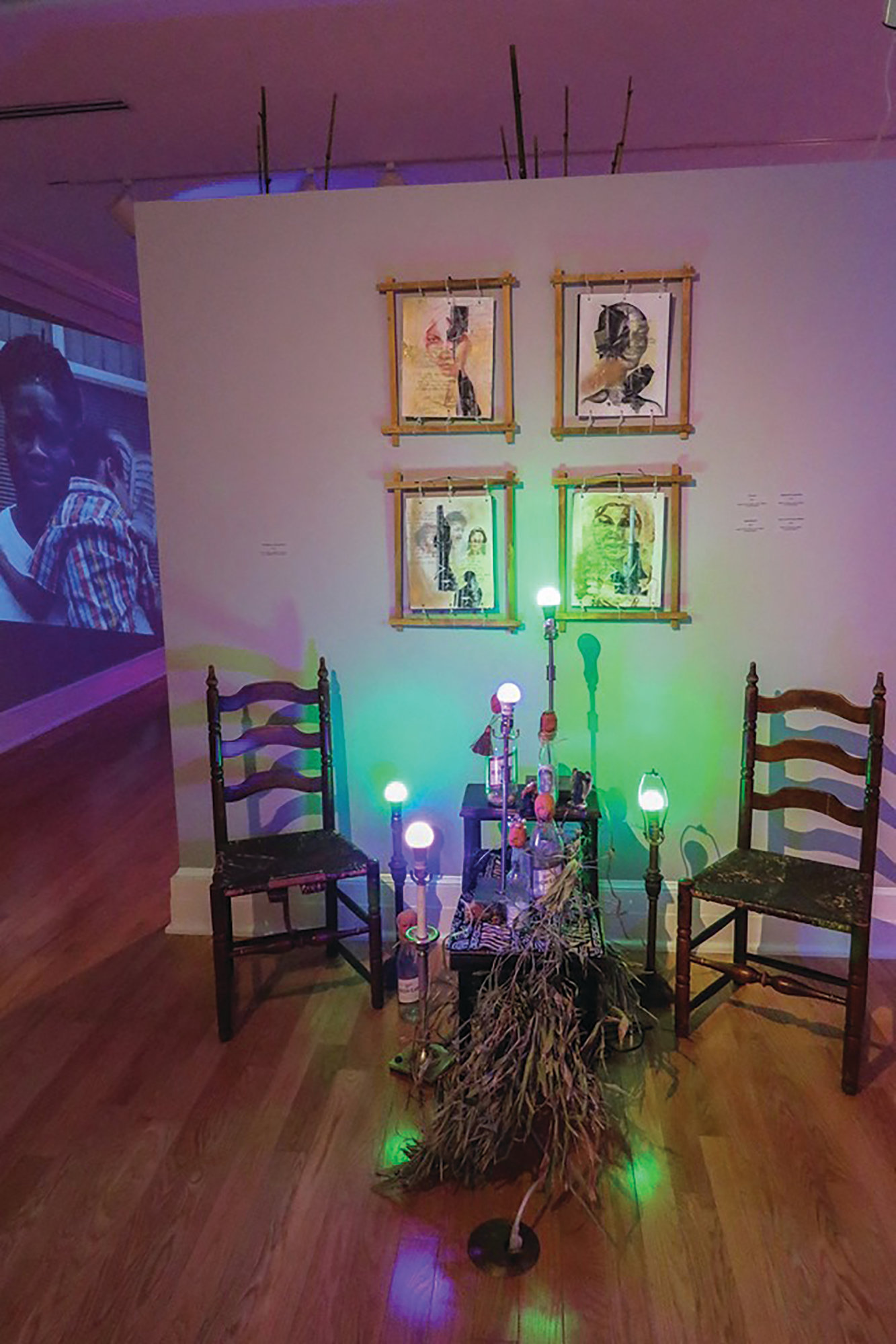The Blues and the Sky: Artists tell stories of black personhood, survival
Special to The Sumter Item
Upon first engaging Angela Davis Johnson's "Weatherin' Between the Canebrake Blues" and Michi Meko's "And then there was Sky" exhibitions at the Sumter County Gallery of Art, I found myself struck by the profound sense of meaning each exhibition houses and how many layers of the human condition each exhibition uniquely speaks to. While very different exhibitions, they feel remarkably seamless in the gallery space, like a continuous human story.
What first strikes the eye and consciousness when encountering Johnson's work is the scope, the scenery and the subjects. When paired rhythmically with the soundscape and media framing of Philadelphia-based digital artist Muthi Reed, a fully realized media thoughtscape crafted by Reed interacts with Johnson's art to fill the full exhibition space with all expressions of blackness.
I felt the gravity of these artists demanding the right for their subjects to take up necessary emotional and personal space. There is no true way to parse all of those elements out, as Johnson has committed to making these all fit so purposefully. There are layers and a full three dimensions in her art and work. There are stories, so clear and beautiful and vibrant. There is a challenge to being still when confronted with her work, and like most great art, it tells many stories to those fortunate enough to spend time with it.
"Weatherin' Between the Canebrake Blues" uses every medium, multimedia, every bit of available canvas space to give voice to black womanhood, black girlhood, vulnerability, strength and surviving trauma. There are still and changing images, sound and dialogue everywhere to envelope and usher you. What Johnson has produced with this exhibition is a kind of open-air chapel for the processing of trauma, guilt, pain and empowerment that black people, and specifically black girls and women, are not typically afforded. That the images and sounds bring about so visceral a feeling only adds to the experience. This work feels very much like a direct challenge to our community and society-wide approach to accepting the generational curses and abuses visited on black lives and psyches.
With her work, Johnson is having a very public conversation about affirming our community and crafting an essential space through her art. She goes so far as to incorporate one such conversation she had with the matriarchs in her family, around abuse and victimization and generational abuse and curses, and secret and truth telling and it all ties in with every other work in her exhibition. "Weatherin' The Canebrake Blues" invites the community around the fire for a family discussion, and there is tremendous power in that feeling and in these works.
With "And then there was Sky," Michi Meko has managed to craft a remarkably coherent narrative and set of stories with elements of survival, reflecting on being, the conscience and the soul and being black in the South. These images and pieces speak over and again of knowing and exploring and being. Black is prominent throughout this exhibition's landscape, with other elements playing more ephemeral roles in that landscape. With "Sky," there is a tremendous depth of meaning in each piece, very focused on life in no true linear fashion. I felt cast out when stepping into this exhibition, left to experience all of the many stories, past/present/future, being told coherently all at once. There was no rush and urgency to make any one statement, rather, imagine a powerful voice actively sharing itself about all of the life it has lived. This freedom and exploration of life and experiences is aided by the use of so many different kinds of materials in the crafting of the work. This exhibition is filled with pieces that tell a 3-D story using all three dimensions and any and all materials necessary. Every item appears to fill several pages and spaces and truly fleshes out and expands our understanding of the life/lives being shared in the exhibition. I first felt the very clear impact of the sea and survival and the South and being alive and black in it, all present and vibrant. You want to have a conversation with this exhibition, and it allows you to do so, at your pace and with plenty of iconography and imagery as landmarks and guides.
Like all great art, the images and sounds and reverberations and meanings in both "Weatherin' Between the Canebrake Blues" and "And then there was Sky" shift and grow and change the more time you spend with them and ruminate on them. Also like all great art, both exhibitions find time to be engaging and challenging and startling and tethered to so many parts of our human condition. One can easily see something new each time he or she engages these exhibitions, and to be certain, both require multiple viewings to be most fully appreciated. Even now, after having left them, I am questioning parts of what I saw and seeing the junctions where these two broadly meaningful sets of work, and their creators, meet. These two exhibitions, brave and timely, are here for us to enjoy as the beautiful things they are and to evolve essential conversations about our lives.
The Sumter County Gallery of Art has brought yet another set of strikingly beautiful and meaningful works and master artists to South Carolina. I urge you to be good to yourself and set aside multiple dates and times to share an emotional space with these works. Let these artists, and their works, live with you for a while, and be better for it.
Angela Davis Johnson will give an artist talk and performance at 6 p.m. Thursday. Michi Meko will be in conversation with Dr. Napoleon Wells at 2 p.m. Saturday, June 8.
Dr. Napoleon Wells is an assistant professor of psychology at Claflin University in Orangeburg. Before coming to Claflin, he was a PTSD treatment specialist at the Dorn VA Hospital. He writes and lectures extensively about a variety of subjects: visual art, hip hop, PTSD and Afrofuturism in popular culture and film.
More Articles to Read




